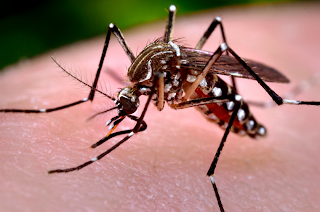aedes aegypti
Aedes (Stegomyia) aegypti (Aedes αηδής Greek: "odious" and Aegypti from the Latin "Egypt") is the nomenclature Taxonomic for the mosquito that is popularly known as mosquito-of-dengue or stilt-brindle, a kind of mosquito Culicidae family from Africa, currently spread over almost the entire world, especially in tropical and subtropical regions, being dependent on human concentration in place to settle.The mosquito is well adapted to urban areas, specifically to human dwellings, which can reproduce and lay their eggs in small quantities of clean, still water, that is, poor in decaying organic matter and salts (which confer acidic characteristics water), which preferably are shaded and outdoors.
Currently, it was discovered that the female does not reproduce clear and only still water instead. The mosquito can breed in water with high levels of pollution, such as sewage. The female observes various factors influenced the growth of the larvae, such as temperature, light and traces of organic matter. The aegypti larvae are light sensitive, which means that grow well in turbid waters.
Females, to perform the biting, can go up to 2 500 m. It is considered vector of serious diseases such as dengue, yellow fever, and chikungunya fever zica. The control of their populations is considered issue of public health.
Description
Aedes aegypti is a mosquito that is active and bites during the day, unlike the anopheles, the malaria vector, that has crepuscular activity. The Aedes aegypti has the preferred victim man and makes almost no audible sound before sticking. Measures less than 1 centimeter, is black with white patches on the body and legs.
Your control is difficult to be very versatile in the choice of breeding which lays its eggs, which are extremely resistant and can survive several months until the arrival of water triggers incubation. Once immersed, the eggs develop rapidly into larvae, which give rise to pupae, from which the adult emerges. Like almost all other mosquitoes, only females feed on blood for the maturation of their eggs. The males feed only on plant and sugary substances. [Citation needed]
For adapt well to various containers, the expansion of these mosquitoes from its original habitat was quick. Aedes aegypti was introduced into South America by boat from Africa. In the Americas, it is believed that his first colonization of the New World took place through the slave ships in the colonial period along with the slaves. In Brazil, the Aedes aegypti had been eradicated in the 1950s; however, in the 1960s and 1970s, he returned to colonize this country, coming from neighboring countries that had failed to promote their complete eradication.
Aedes aegypti is present in tropical regions of Africa and South America, reaching the island of Madeira in Portugal and the state of Florida, in the United States. In this area, Aedes aegypti has been declining due to competition with other species of the same genus Aedes albopictus. This, however, does not bring good news, since the A. albopictus is also a vector of dengue, as well as various types of equine encephalitis. But in Brazil, the only one that transmits dengue is A.aegypti. And the competition between the two species is due to the fact that the female A. aegypti to mate with both the male of their species, as with the male of A. albopictus which is more aggressive and, being of another species, generates infertile eggs thereby reducing the population of A. aegypti. Repellents based compound DEET (N, N-dietilmetatoluamida) are recommended against Aedes aegypti.
symptoms that the mosquito aedes aegypti transmits
Dengue and Chikungunya symptoms and have similar signs, while the Dengue stands out for pain in the body, Chikungunya stands out for pain and swelling in the joints. Zika already stands for a lower fever (or absence of fever), many spots on the skin and itching in the body.Dengue
The first symptom of dengue are high fever, between 39 ° and 40 ° C. It has sudden onset and usually lasts 2 to 7 days accompanied by headache, body aches and joints, prostration, weakness, pain behind the eyes, rash and itching in the body. There may be weight loss, nausea and vomiting.Chikungunya
Symptoms such as high fever, muscle and joint pain, headache and rash (rash). The signals typically last from 3 to 10 days.Zika
Its main symptom rash (rash) with itching, low fever (or absence of fever), red eyes without discharge or itching, joint pain, muscle pain and headache. Usually the symptoms disappear after 3 to 7 days.dangers and complications
Dengue
The main complication is severe dehydration, which occurs without the person realizing it. So it is important to take plenty of fluids when the person is with dengue.Chikungunya
The main complication is staying for a long time, the pain and swelling in the joints, sometimes preventing people from returning to their activities.Zika
The most frequent complications have been the neurological manifestations such as facial paralysis and weakness in the legs, such as the development of Guillain-Barré syndrome.treatment
The symptoms may be similar, but the treatment is different for each disease. Go to the clinic if you are experiencing symptoms. Avoid self-medication.
If the medical staff to detect the need, the patient will be referred to the Hospital Couto Maia, referral center for infectious diseases in Bahia. The Couto Maia meets only cases referred to the unit and regulated.


No comments:
Post a Comment